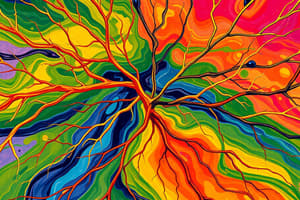Podcast
Questions and Answers
What is the main effect of Beta-2 adrenergic agonists?
What is the main effect of Beta-2 adrenergic agonists?
- Decreased heart rate and contractility
- Bronchoconstriction and vasoconstriction
- Bronchodilation and vasodilation (correct)
- Increased sympathetic activity
Which drug is an example of an Alpha-1 adrenergic antagonist?
Which drug is an example of an Alpha-1 adrenergic antagonist?
- Phentolamine (correct)
- Metoprolol
- Albuterol
- Pilocarpine
What is the main effect of Cholinergic Agonists on muscarinic receptors?
What is the main effect of Cholinergic Agonists on muscarinic receptors?
- Decreased glandular secretion and sphincter tone
- Increased bronchoconstriction and vasoconstriction
- Decreased heart rate and increased glandular secretion (correct)
- Increased heart rate and intestinal motility
Which drug is an example of a Nicotinic Agonist?
Which drug is an example of a Nicotinic Agonist?
What is the main role of Cholinergic Antagonists?
What is the main role of Cholinergic Antagonists?
Flashcards are hidden until you start studying
Study Notes
Peripheral Nervous System Drugs: Understanding Adrenergic and Cholinergic Agents
The peripheral nervous system (PNS) is responsible for transmitting sensory information from the body to the central nervous system (CNS) and coordinating motor responses back to the body. While the PNS itself does not have its own pharmacology, there are several classes of medications that can interact with its components to either stimulate or inhibit neural activity. Two such classes of agents are adrenergic drugs and cholinergic drugs.
Adrenergic Drugs
Adrenergic drugs target the sympathetic nervous system, which plays a role in the fight-or-flight response. These drugs can be classified into two main categories: agonists and antagonists.
Adrenergic Agonists
Adrenergic agonists mimic the effects of endogenous catecholamines by binding to specific receptor sites on PNS cells. They can be further divided into the following subcategories:
Alpha-1 Agonists
Alpha-1 adrenergic agonists stimulate alpha-1 receptors, which increase blood pressure and decrease blood flow to the kidneys. Examples include phenylephrine and methoxamine.
Alpha-2 Agonists
Alpha-2 agonists stimulate alpha-2 receptors, leading to vasoconstriction, decreased blood pressure, and decreased glandular secretion. Examples include brimonidine and timolol.
Beta-1 Agonists
Beta-1 adrenergic agonists stimulate beta-1 receptors, increasing heart rate, increasing contractility, and increasing blood pressure. Examples include albuterol and dobutamine.
Beta-2 Agonists
Beta-2 adrenergic agonists stimulate beta-2 receptors, leading to bronchodilation and vasodilation. Examples include albuterol and formoterol.
Adrenergic Antagonists
Adrenergic antagonists block the effects of endogenous catecholamines by binding to specific receptor sites on PNS cells. They can be further divided into the following subcategories:
Alpha-1 Antagonists
Alpha-1 adrenergic antagonists block alpha-1 receptors, leading to decreased blood pressure and increased renal blood flow. Examples include phentolamine and phenylephrine.
Alpha-2 Antagonists
Alpha-2 adrenergic antagonists block alpha-2 receptors, leading to decreased vasoconstriction and increased glandular secretion. Examples include phenylephrine and brimonidine.
Beta-1 Antagonists
Beta-1 adrenergic antagonists block beta-1 receptors, leading to decreased heart rate, decreased contractility, and decreased blood pressure. Examples include propranolol and metoprolol.
Beta-2 Antagonists
Beta-2 adrenergic antagonists block beta-2 receptors, leading to bronchoconstriction and vasoconstriction. Examples include albuterol and salmeterol.
Cholinergic Drugs
Cholinergic drugs target the parasympathetic nervous system, which plays a role in restoring homeostasis after the fight-or-flight response has ended. They can also modulate both the sympathetic and autonomic systems. Like adrenergic drugs, they can be classified into agonists and antagonists.
Cholinergic Agonists
Cholinergic agonists increase acetylcholine levels in the synaptic cleft by directly stimulating muscarinic receptors or nicotinic receptors.
Muscarinic Agonists
Muscarinic agonists selectively activate muscarinic receptor types M1 to M5, leading to various physiological effects such as decreased heart rate, increased glandular secretion, bronchodilation, decreased intestinal motility, and increased sphincter tone. Examples include bethanechol and pilocarpine.
Nicotinic Agonists
Nicotinic agonists selectively activate nicotinic receptors, leading to depolarization of postsynaptic neurons or skeletal muscle cells. Examples include curare and suxamethonium.
Cholinergic Antagonists
Cholinergic antagonists block the actions of acetylcholine by competitively inhibiting nicotinic or muscarinic receptors.
Muscarinic Antagonists
Muscarinic antagonists block muscarinic receptors, leading to varying degrees of symptomatic relief depending on the specific receptor subtype blocked. Examples include phentolamine and propranolol.
Nicotinic Antagonists
Nicotinic antagonists block nicotinic receptors, leading to decreased depolarization of postsynaptic neurons or skeletal muscle cells. Examples include curare and tubocurarine.
Studying That Suits You
Use AI to generate personalized quizzes and flashcards to suit your learning preferences.




